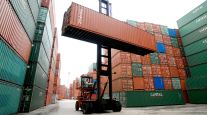Intermodal Freight Increases 2.6% Despite Harsh Winter, IANA Says
This story appears in the May 12 print edition of Transport Topics.
Truck-rail shipments rose 2.6% in the first quarter from a year earlier despite significant winter weather challenges, the Intermodal Association of North America reported.
The trade group said May 5 shipments totaled 3.77 million between January and March, including virtually identical amounts of domestic and international freight.
Domestic shipments rose 4.1% to 1,886,188, and international totaled 1,891,266, a rise of 1.1%. Trailer shipments, which accounted for about 11% of total volume, were up 7.5% from a year earlier.
“Severe weather during the first quarter impacted the entire transportation network,” IANA President Joni Casey said. “But despite these challenges, intermodal volumes showed modest growth.”
“The industry’s ability to add almost 100,000 first-quarter loads compared to last year, despite those network challenges, highlights the value of intermodal to the broader freight transportation network,” the report said.
IANA cited “exceptional challenges,” such as reduced economic activity and demand due to weather, as well as some network delays and congestion.
“It is possible that the congestion in the overall transportation network made it harder to obtain equipment, and shippers were forced to put into service whatever was available,” the IANA report said, noting that trailer shipment growth was strongest in the areas where the weather was worst, particularly the Northeast.
Larry Gross of FTR Associates, emphasized the role of congestion.
“The trailer numbers are a byproduct of the congestion that has been slowing container equipment turns on the domestic side,” he told Transport Topics on May 6. “Because there is a fixed amount of domestic container capacity, the
53-foot trailer has been flowing in to take up the slack.”
“It is not correct to say that rail-service issues are solely the effect of the winter,” Gross said. “This was becoming evident prior to when the worst of the winter hit.”
He noted, for example, that average intermodal train speeds declined 7% in December, over the prior year, based on a four-week moving average.
Gross hesitated to say the recent uptick in intermodal trailer shipments, which have risen three consecutive quarters sequentially, will become a trend. However, he said the recent trailer-shipment growth could be a sign of underlying demand from truckload fleets that use their own equipment to test out intermodal. It also could be an indication the driver shortage is pushing fleets to use more intermodal.
IANA said that full-year volume gains could be in the 3% to 4% range, dragged down by subpar first-quarter results. Even 3% growth would create another record, topping IANA’s 2013 mark of 15.5 million shipments.
IANA also said international trends are difficult to track because of the timing of holidays.
“It will take some more time to discern where the international segment will go in 2014,” the report said, because there may be further market distortions with shippers choosing other ports as the June 30 expiration of the West Coast port labor contract approaches.
IANA said winter weather reduced over-the-road truck capacity by 5-7%, pushing up freight rates.
“Going forward, OTR capacity and rates will be harder to forecast, since normal seasonal data corrections were overshadowed by weather impacts at the beginning of this year,” the report said. “Trucking is near a critical tipping point, with marginal reserves and tolerance to apply to market shocks like the next snowstorm or demand surge.”
Because the normal surge began in March and will continue through June, IANA said there will be an atypical seven-month period of tight capacity, making it difficult to know how strong 2014 will be.




